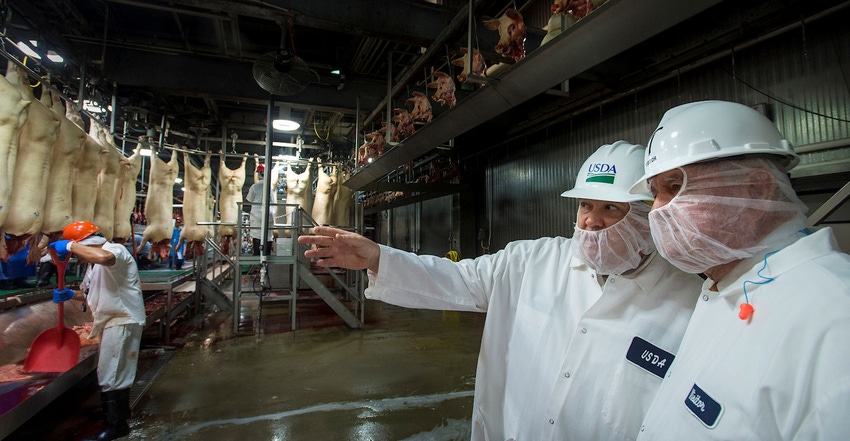
Left unchallenged, a recent federal district court ruling limiting line speeds at pork processing plants will result in a 2.5% loss in pork packing plant capacity nationwide, and more than $80 million in reduced income for small U.S. hog farmers, according to an analysis by Dermot Hayes, an economist with Iowa State University. At the start of April, the U.S. District Court of Minnesota issued a decision in United Food and Commercial Workers Union, Local No. 663 v. U.S. Department of Agriculture, requiring the new administration to decide how to proceed on the 2019 rule to change line speeds on hog slaughter inspection lines.
The National Pork Producers Council is urging USDA to intervene before the ruling takes effect at the end of June. The ruling will dramatically reduce hog farmer market power—particularly smaller producers located near impacted plants—and undermine pork industry competition, NPPC says.
The federal court’s decision struck down a provision of USDA’s New Swine Inspection System allowing for faster harvest facility line speeds. NSIS, initiated during the Clinton administration and evaluated at five pilot plants over 20 years, was approved for industry-wide adoption in 2019. NSIS modernized an inspection system that had remained unchanged for more than 50 years.
Related: Court issues stay on hog slaughter inspection rule
At the time of the court ruling, a Food Safety and Inspection Service spokesperson noted, “The Administration is deeply committed to worker safety and a safe, reliable food supply. This is an important decision, and we are reviewing it closely in light of the authorities, mission and mandate of the Food Safety and Inspection Service.”
NPPC is urging USDA to appeal the ruling, seek a stay while the appeal is considered and request the agency pursue a new, fast-tracked rulemaking that better reflects the modern processing plant technologies and practices and allows for higher line speeds.
Following the NPPC request for USDA action, an FSIS spokesperson says as of May 25, “Only the DOJ’s Office of the Solicitor General decides whether to appeal this decision and, to date, no determination has been made.”
NPPC says the court’s ruling will have the opposite effect sought by those seeking to expand the number of meat packing plant facilities. Lawmakers have recently called for increasing the number of pork processing facilities nationwide by bringing smaller state plants up to federal inspection standards. These facilities represent less than 1% of total harvest capacity.
“The U.S. pork production system, the most advanced in the world, is characterized by robust competition, innovation and efficiency. With the stroke of a judge’s pen, the lives of many hog farmers will be upended if this misguided ruling takes effect,” says NPPC President Jen Sorenson, communications director for Iowa Select Farms in West Des Moines, Iowa. “The lost revenue projected by Dr. Hayes is not theoretical; it is based on breeding decisions made several month ago and pigs already in the production cycle that will go to market in a few months.”
Impact from pork packers
Packers will likely use Force Majeure provisions to declare their pricing contracts with hog farmers null and void, forcing these farmers to sell their hogs on the spot market.Hayes explains the pork industry recently faced similar circumstances when production outstripped available capacity. In the fall of 2019, when capacity was at the same level to be established with this court ruling, the spot price for hogs was $10.70/cwt lower than what farmers would otherwise have received.
"Given the similarities between market conditions in 2019 and the likely outcome of USDA inaction, I expect hog farmers will lose an estimated $83.2 million due to capacity reduction and related fallout. Smaller producers who lack negotiating power, especially those located near the impacted processing facilities, will incur a disproportionate amount of these losses," Hayes writes.
According to Hayes, while the court decision will affect all hog farmers, small hog farmers will disproportionately bear the brunt, especially those near affected processing plants. Michigan pork producer Ed Reed sends 80% of his hogs to an affected plant 15 miles away from his farm. “I'm a small farm and we're trying to capture as much value as we can,” he said. “If we were to slow the plant down…we’re going to have capacity issues,” he said, with the next closest processing plant two-and-a-half hours away. Those added transportation costs may be too much for producers to bear, he noted.
“As a small producer, small changes in packer capacities impact us,” says Minnesota hog farmer Dani Stonestrom. “If we can't pay our people because the funds aren't coming in, we have to let them go. In a small community, where we’re a large employer, removing the jobs from our community is detrimental to these families and the vitality of the community as a whole,” she adds.
About the Author(s)
You May Also Like






